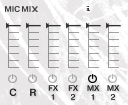Recording and mixing
Although Spitfire is known for a series of orchestral libraries recorded in very reverberant sounding environments, especially the large Lyndhurst Hall of Sir George Martin’s Air Studios, they decided, for LCO Strings, to abandon the large, converted church and record in a much drier environment. The recording was carried out in the little reverberating studio at King’s Cross, owned by Spitfire themselves. Ribbon and tube microphones were used, amplified by Neve preamps and digitized by Cranesong converters.
You can mix and match microphones and ready-made mixes.
The result is picked up by two sets of microphones - close, and room - that can be mixed at will. Spitfire themselves offer two ready-made mixes (one - MX1 - with a natural sound, and another one - MX2 - already compressed). They also offer two very effected mixes, one of which (FX1) very dark and muffled, with very filtered extreme frequencies, and the other (FX2) with a fascinating synthetic and grainy sound, rich of tape wow and flutter.
Natural mix (Mix 1).
The FX1 mix is extremely filtered.
The FX2 mix has a tape-like quality.
The close recording is very present and raw. As usual, Spitfire defaults the samples at a very low level, to avoid distortion in the mix. The immediate result is that you are at a considerable perceived distance from the musician. If the orchestration is transparent enough, one can, however, increase the volume of the Kontakt Instrument, and consequently increase the sense of presence and body of the sound. Which is remarkable, and even disturbing with the most extreme articulations.
intro | overview | lco | recording | articulations | ostinatum | conclusion